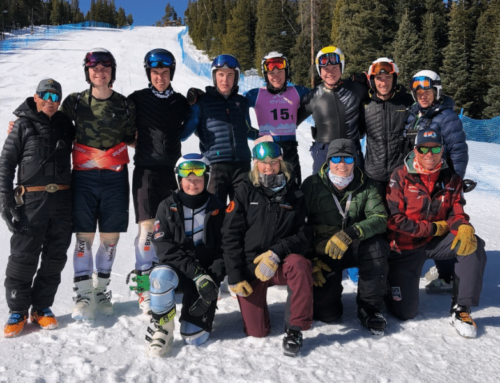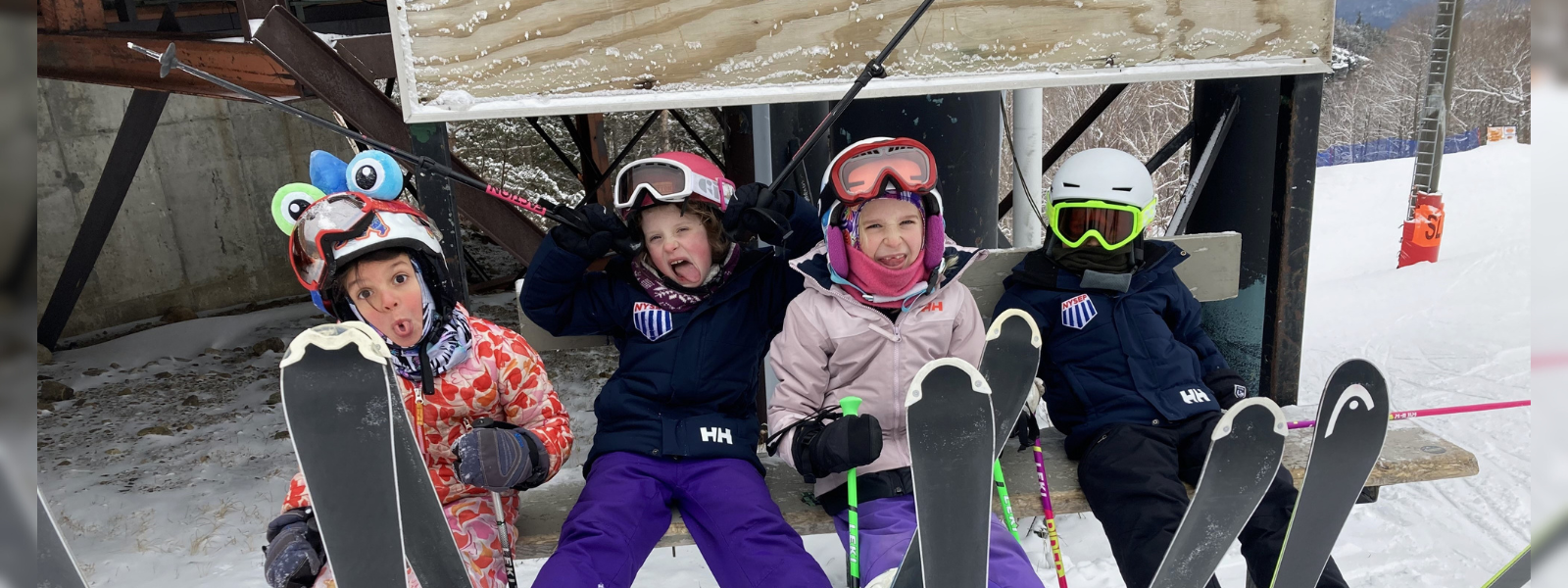8 Tips on Racing a Speed Event
The average masters racer can go 65 miles per hour in super G, 75 mph in downhill — not quite World Cup speeds, but not life in the slow lane, either.
For some, going this fast on skis is an addictive adrenaline rush. For others, the thought of it is enough to stay glued to the couch, watching the World Cup.
But for most masters racers, the decision to race speed events can be complicated.
Racing speed events counts toward combined results, and it helps our performance in tech events, especially GS, because it makes us more comfortable at faster speeds. Plus, it’s really fun when the conditions are good, and it’s a challenge. It’s part of ski racing.
On the other hand, speed events have a higher risk of injury — crashing at 60 mph is intuitively much worse than at 20 mph.
And in the case of downhill, the time commitment (three days instead of one day because of the required training runs, which are usually midweek) is a strong deterrent for all but the retired or self-employed among us.
Plus, most of us rarely have the chance to practice super G or downhill outside of a race, a confidence bust unless we raced speed events as a junior. Finally, the highly specialized, longer skis are almost impossible to find, especially masters-friendly models with, say, a 33-meter radius in super G rather than the FIS-required 40- to 45-meter skis.
So here to help you navigate your need for speed are an old pro and a newbie who offer their take on the sometimes terrifying courses.
Luke Keenan, Addicted to Speed
Luke Keenan clinched his fifth Phillips 66 National Speed Series title at Schweitzer Mountain Resort at the end of February and travels across the U.S. each winter to enter super G’s and downhills. Now age 33, he became hooked on highway speeds the first year he started ski racing, at age 13.
“I had a pair of 195 cm Dynastar G9s,” says Keenan. “I could carve them in speed events but not in tech. The other racers weren’t carving as much, so I did well, especially in downhill.”

According to Luke Keenan, he carves his best turns in speed events. Lisa Ballard photo
Downhill is more about speed, finding the fall line and staying in a tuck, says Keenan. “You can be as creative as you want with line,” he says. “There might be a 30- to 40-foot difference between racers. Super G used to be more like downhill, but it has evolved into open GS, at least for the masters. In downhill, you slow down on the flats. In super G, you slow down because of the turns.”
Keenan also favors downhill for the training runs. It’s the only alpine discipline event that requires them, which is great for masters racers, because it might be the only chance they get to train speed. Assuming two training runs, Keenan uses the following strategy per run:
Training Run No. 1: Ski the right line.
Training Run No. 2: Tighten up the line.
Training Run No. 3 or Race: Ski the race line.
What are his takeaway tips? “Look at the jumps, the fall line and the rise line,” he says. “There’s a lot of thinking to it. Your skiing can improve a lot between the first training run and the race.”
Keenan takes every run, including the training runs, seriously. “If you do something stupid or you’re not in the right mindset when you leave the starting gate, you’re going to have a suboptimal result,” he says. “You need to know where you are and where you’re going at every moment — otherwise bad stuff can happen in a hurry.”
Physical fitness is paramount to success in speed, says Keenan. “As a kid, I worked out maybe three days per week, but now it’s six days per week,” he says. “When you get older, it takes twice as much effort. Most people focus on wax, but if you’re too tired to turn at the bottom of the course, it doesn’t matter if you spent $100 on wax. So many racers throw away the last four turns.”

Left to right: Luke Keenan, Sean McCann, Bill Tomcich and Dave Kornish gather at the awards ceremony at Schweitzer Mountain. All four chase points on the Phillips 66 Speed Series. Lisa Ballard photo
Amanda Kleist: A Fast First-Timer
The start list at the Phillips 66 Speed Series at Schweitzer Mountain Resort also included a few rookies such as Amanda Kleist from Red Lodge Mountain, Mont., competing on borrowed skis and wearing a borrowed ski suit.
The desire to go fast, though, was all hers. Kleist, 39, skied a few times in high school, then took up the sport recreationally in 2002. This winter is her first in gates, she says, and the super G’s at Schweitzer were her first USSA masters events.
 “The hardest part is keeping your head in the game,” she says. “You’ve got to focus mentally when you’re going faster. I talk to myself a lot. I don’t really know what I’m doing, but I remind myself about correct technique — otherwise I go to my default, which is not right.”
“The hardest part is keeping your head in the game,” she says. “You’ve got to focus mentally when you’re going faster. I talk to myself a lot. I don’t really know what I’m doing, but I remind myself about correct technique — otherwise I go to my default, which is not right.”
Other challenges to an inexperienced racer are the longer lengths and radii of the skis. “Initially the skis felt awkward,” says Kleist. “I wasn’t used to huge boards hanging off my feet. I spent the last 16 years on a pair of recreational skis, but those super G skis made going fast more comfortable.”
For Kleist’s speed debut at Schweitzer, she got two bluebird days, warm air temperatures and firm but grippy snow. The exceptional conditions helped give her the confidence to race. “It was the perfect welcome to ski racing,” she says. “Don’t do it if the weather isn’t good, especially if you haven’t done it before. Don’t gut it out if it’s not ideal conditions.”
Would she do it again? “Heck yes!” she says, “I just bought a speed suit online. It’s a blast!”

This might explain Kleist’s inclination to speed: her day job is flying planes. Courtesy of Amanda Kleist
How Fast Will You Go?
Here are the maximum speeds (+/- 5 mph) that a masters racer can expect to hit in each event, depending on the terrain, the course and the snow conditions.

This shows a section of a recent masters super G at Schweitzer Mountain. Super G’s for masters have evolved into wide-open GS, though speeds often exceed 60 mph. Lisa Ballard photo
How To Go Faster, Masters-Style
If you don’t have the opportunity to train for a speed event, here are 8 tips to help you enter a Super G or downhill with more confidence.
























